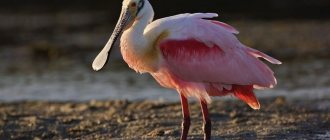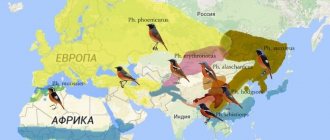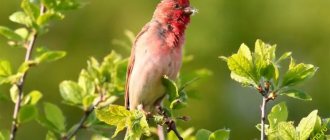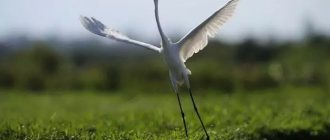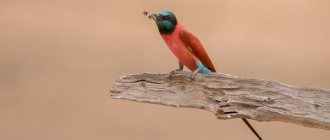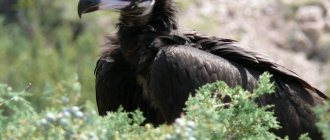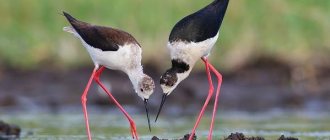In several US states, the official symbol is one small red bird. It turns out that this is a cardinal bird. A very unusual and loud name for such a small feathered creature. What did the red cardinal deserve such honor? Maybe with its unusual and noticeable plumage? Or maybe beautiful singing?
Male red or Virginia cardinal (Cardinalis cardinalis)
The red cardinal is also called the Virginia cardinal. This bird belongs to the cardinal family.
Painted Bunting Cardinal (Passerina ciris)
Origin of the species and description
Photo: Red Cardinal
The red cardinal (Cardinalis cardinalis) is a North American cardinal bird. It is also known as the northern cardinal. The common name, as well as the scientific name, red cardinal refers to cardinals of the Roman Catholic Church who wear distinctive red robes and caps. The term "northern" in the common name refers to its range, as it is the northernmost cardinal species. There are 19 subspecies of red cardinals, which differ mainly in color. Their average lifespan is approximately three years, although some have a lifespan of 13 to 15 years.
Video: Red Cardinal
The red cardinal is the official state bird of at least seven eastern states. Extensive across the Southeast, it has been expanding its range northward for decades, and it now brightens winter days with its color and whistling song as far north as southeastern Canada. Feeders supplied with sunflower seeds may have helped its spread north. West of the Great Plains, the red cardinal is largely absent, but in the desert southwest it is locally common.
Fun fact: Many people are puzzled every spring when the red cardinal attacks its reflection in a window, car mirror or shiny bumper. Both males and females do this, and most often in the spring and early summer, when they are obsessed with protecting their territory from any intruders. Birds can fight these intruders for hours without giving up. A few weeks later, as levels of aggressive hormones decline, these attacks should stop (although one female maintained this behavior every day for six months without stopping).
Relationships with people[edit]
The northern cardinal is found in residential areas throughout its range. Backyard birds attract it with feeders containing seeds, especially sunflower seeds and safflower seeds. Although some controversy concerns bird feeding, increased backyard feeding by humans has generally been beneficial for the species. It is listed as a species of Least Concern by the IUCN Red List, with an estimated global range of 5,800,000 km2 (2,200,000 sq mi) and a global population of approximately 100 million. [1] Populations appear to remain stable and are not in danger of reaching the threshold for listing as endangered, which requires a decline of more than 30% over ten years or three generations. [1] It was once valued as a pet because of its bright color and distinctive song. [11] In the United States, the species enjoys special legal protection under the Migratory Bird Treaty Act of 1918, which also prohibited their sale as cage birds. [29] It is also protected by the Migratory Bird Treaty of Canada. [30] Capturing, killing, or possessing northern cardinals is illegal, and breaking the law is punishable by a fine of up to $15,000 and up to six months in prison. [31]
In the United States, the northern cardinal (simply called "cardinal") is the mascot of numerous sports teams; however, most teams depict a bird with a yellow beak and legs. In professional sports, it is the mascot of the St. Louis Cardinals in Major League Baseball's National League and the Arizona Cardinals in the National Football League, who for many years have also been based in St. Louis. In college athletics, it is the mascot of many schools, including Ball State University, Catholic University of America, Illinois State University, University of the Incarnate Word, Lamar University, University of Louisville, Massachusetts College of Pharmacy and Health Sciences, North Idaho College, Otterbein University, St. John's College Fisher, State University of New York at Plattsburgh, Wesleyan University, Wheeling University, and William Jewell College.
The red cardinal is featured in the logo of Polish video game developer CD Projekt.
A 2016 study of West Nile virus transmission in the United States conducted in Atlanta, Georgia, found that unlike other species, northern cardinals biologically suppress the disease when infected. [32]
Appearance and features
Photo: What a red cardinal looks like
Red cardinals are medium-sized songbirds. Males are bright red except for a black facial mask. They are one of the most recognizable birds due to their bright red color. Females are light brown or light greenish brown with reddish highlights and do not have a black mask (but parts of their face may be dark).
Both males and females have thick, orange-red, cone-shaped bills, a long tail, and a distinctive crest of feathers on the top of their heads. Males are slightly larger than females. Males are 22.2 to 23.5 cm long, while females are 20.9 to 21.6 cm long. The average weight of adult red cardinals is 42 to 48 g. The average wing length is 30.5 cm. Juveniles red cardinals are similar to females, but have a gray rather than orange-red bill.
Fun fact: There are 18 subspecies of red cardinals. Most of these subspecies differ in the color of the female's mask.
Unlike many other songbirds in North America, both male and female red cardinals can sing. Typically, only male songbirds can sing. They have distinct phrases such as the very sharp "chip-chip-chip" or a long greeting. They tend to choose very high pitches for singing. The male will use his call to attract a female, while the female red cardinal will sing from her nest, perhaps calling to her mate as a message for food.
Fun fact: The oldest recorded red cardinal was a female, and she was 15 years and 9 months old when she was found in Pennsylvania.
Links[edit]
- ^ a b c d
BirdLife International (2012).
" Cardinalis cardinalis
".
IUCN Red List of Threatened Species
.
2012
. Retrieved November 26, 2013.CS1 maint: ref=harv (link) URL of old form - Linnaeus, Karl (1758). Systema naturae per regna tria naturae, secondary classes, ordinal, genera, species, cum characteribus, differentials, synonyms, loci. Tomus I. T (Laurentii Salvii)
(in Latin). item 824. - Bailey, Florence Merriam (1921). A Guide to the Birds of the Western United States
. Houghton Mifflin Harcourt. S. 500. - ^ a b c d e
Richison, Gary (1997).
Northern cardinal
. Stackpole Books. clause 2. ISBN 0-8117-3100-6. - ^ a b
Holloway, Joel Ellis (2003).
Dictionary of Birds of the United States: Scientific and Common Names
. Timber Press. paragraph 59. ISBN 0-88192-600-0. - Duchesne, Bob (September 21, 2012). "Reproduction of cardinals is a relatively recent event". Bangor Daily News
. Archived 10/06/2014. - Gill, Frank; Donsker, David, ed. (2019). "Cardinals, Deaffoots, and Allies (tanagers)". World Bird List, version 9.2
. International Union of Ornithologists. Retrieved June 26, 2022. - Dunning, John B., ed. (1992). CRC Handbook of Avian Body Masses
. CRC Press. ISBN 9780849342585. - ^ a b c
Dewey, Tanya;
Kirschbaum, Kari; Crane, Jonathan (2002). Cardinalis cardinalis
. University of Michigan Museum of Zoology. Archived from the original on February 24, 2015. Retrieved August 24, 2007. - ^ a b
"Northern cardinal
Cardinalis cardinalis
. US Geological Survey. Archived from the original on August 20, 2014. Retrieved November 8, 2007. - ^ a b
Wright, Mabel Osgood (1907).
Birdcraft: A Field Book of Two Hundred Songs, Game and Waterfowl
. Macmillan Publishing. paragraph 161. - ^ a b
Cornell Lab of Ornithology.
Cardinalis cardinalis
. Cornell University. Archived from the original on January 16, 2015. Retrieved August 24, 2007. - Krinsky, Norman I; Main, Susan T. and Sis, Helmut (2004). Carotenoids in Health and Disease
. CRC Press. p. 258. ISBN 0-8247-5416-6. - ^ a b
McGraw, Kevin J.;
Hill, Jeffrey E.; Stradi, Riccardo; Parker, Robert S. (2001). "The influence of carotenoid accumulation and utilization on the maintenance of species-typical plumage pigmentation in male American goldfinches ( Carduelis tristis
) and northern cardinals (
Carduelis cardinalis
)."
Physiological and Biochemical Zoology
.
University of Chicago Press. 74
(6):843–852. DOI: 10.1086/323797. PMID 11731975. S2CID 10265039. - McGraw, Kevin J; Hill, Geogffrey E.; Parker, Robert S. (August 2003), "Carotenoid Pigments in the Mutant Cardinal: Implications for Genetic and Enzymatic Mechanisms Controlling Carotenoid Metabolism in Birds", Condor
,
105
(3):587–592, doi:10.1650/7281, S2CID 32164111 - Dennis Pillion. A "one in a million" yellow cardinal spotted in Alabama. AL.com. February 22, 2022
- A "one in a million" yellow cardinal called the "Sunny" spotted one in Florida." FOX 35 Orlando
. October 15, 2022. - toughlittlebirds (December 27, 2012). “How do birds keep warm?” . Cool birds
. Retrieved February 5, 2016. - Robison, British Columbia; Tveten, John L (1990). Birds of Houston
. University of Texas Press. paragraph 59. ISBN 0-89263-303-4. - Anderson, Mary E.; Conner, Richard N. (1985). "Northern Cardinal Song in Three Woodland Habitats in East Texas." Wilson's Bulletin
.
97
(4):436–449. - ^ a b
Elliott, Lang;
Read, Marie (1998). Common birds and their songs
. Houghton Mifflin Field Guides. paragraph 28. ISBN 0-395-91238-5. - Jump up
↑ Yamaguchi, Ayako (1998).
"Sexually dimorphic learned birdsong in a northern cardinal." Condor
.
100
(3):504–511. DOI: 10.2307/1369716. JSTOR 1369716. - ^ a b
Terres, J. K. (1980).
Audubon Society Encyclopedia of North American Birds
. New York, NY: Knopf. P. 293. ISBN 0-394-46651-9. - ^ a b
"Northern Cardinal - Introduction |
Birds of North America on the Internet". birdsna.org
. Retrieved March 6, 2022. - ^ a b c d
Harrison, Hal H. (1979).
A Field Guide to Western Bird's Nests
. Houghton Mifflin Field. p. 228. ISBN 0-618-16437-5. - ^ a b
Davy, Oliver (1900).
Nests and eggs of North American birds
. D. Mackay. pp. 399 -400. - "Northern Cardinal". Pennsylvania State University. 2002. Archived December 26, 2013.
- Halkin, S., S. Linville. (1999). Northern cardinal ( Cardinalis cardinalis
).
pp. 1-32 in A. Poole, F. Gill, eds. Birds of North America
, Vol. 440. Philadelphia, PA: Birds of North America. - "Birds Protected by the Migratory Bird Treaty Act". US Fish and Wildlife Service. Archived from the original on 2007-10-10. Retrieved October 14, 2007.
- "50 CFR 10.13 - List of Migratory Birds". Code of Federal Regulations
. Cornell Law School. Retrieved February 23, 2015. - "16 U.S. Code Title 7, Subchapter II of the Migratory Bird Treaty Act". Code of Federal Regulations
. Cornell Law School. Retrieved October 14, 2007. - Levine, Rebecca S.; and others. (November 2016) [June 9, 2016 (online publication)]. "Super suppression: reservoir competence and mosquito host shift timing combine to reduce West Nile virus spread". American Journal of Tropical Medicine and Hygiene
.
95
(5):1174–1184. DOI: 10.4269/ajtmh.15-0809. PMC 5094236. PMID 27503511. Archived from the original on August 17, 2016. Retrieved August 25, 2016. - DeValinger Jr., Leon (July 8, 1940). "Letters to the Editor". Life
: 4. Retrieved February 23, 2015.
Where does the red cardinal live?
Photo Red cardinal in America
There are an estimated 120 million red cardinals in the world, with the majority living in the eastern United States, followed by Mexico and then southern Canada. In the United States, they can be found from Maine to Texas and south through Mexico, Belize and Guatemala. They also live in parts of Arizona, California, New Mexico and Hawaii.
The red cardinal's range has expanded over the past 50 years, including New York and New England, and continues to expand north and west. Experts believe this is partly due to the increase in cities, suburbs and people providing food year-round, making it easier for them to survive in colder climates. Red cardinals tend to live in dense vegetation such as forest edges, overgrown fields, hedgerows, wetlands, mesquite and ornamental landscapes.
Thus, red cardinals are native to the non-Arctic region. They are found throughout eastern and central North America from southern Canada to parts of Mexico and Central America. They have also been introduced in California, Hawaii and Bermuda. Red cardinals have expanded their range significantly since the early 1800s, taking advantage of moderate temperatures, human habitation, and the additional food available at bird feeders.
Red cardinals prefer forest edges, hedges and vegetation around houses. This may be part of the reason for their increase in numbers since the early 1800s. Red cardinals also benefit from large numbers of people feeding them and other seed-eating birds in the backyard.
Now you know where the red cardinal is found. Let's see what this bird eats.
How does a person use a cardinal?
Perhaps the red cardinal is used by humans only as an ornamental animal. People keep cardinals at home as songbirds with an incredibly beautiful voice. The red cardinals “dedicate” wonderful “serenades” to caring owners, listening to which people get great pleasure!
Flashes of flame on the snow...
If you find an error, please select a piece of text and press Ctrl+Enter.
What does the red cardinal eat?
Photo: Red cardinal bird
Red cardinals are omnivores. The typical diet of a red cardinal consists primarily of seeds, grains and fruits. Their diet is also supplemented by insects, which are the main source of food for their chicks. Some of their favorite insects include beetles, butterflies, centipedes, cicadas, crickets, flies, katydids, moths and spiders.
During the winter months they rely heavily on seeds supplied in feeders, with butter sunflower seeds and safflower seeds being their favorites. Other foods they enjoy include dogwood, wild grapes, buckwheat, grasses, sedges, mulberries, blueberries, blackberries, sumac, tulip tree and corn. Blueberry, mulberry and blackberry plants are excellent options for planting as they provide both a food source and cover due to their bushiness.
To maintain their appearance, they consume grapes or dogwood berries. During the digestion process, pigments from fruits enter the bloodstream, into the feather follicles and crystallize. If the red cardinal cannot find berries, its hue will gradually begin to fade.
Fun fact: Red cardinals get their bright colors from pigments found in the berries and other plant materials in their diet.
One of the most important things you need to attract red cardinals is a bird feeder. Unlike many other birds, cardinals cannot change their direction quickly, so bird feeders must be large enough for them to land easily. They want to feel protected while they eat, so it is best to place the feeder about 1.5-1.8 m above the ground and near trees or shrubs. Red cardinals are also ground feeders and will appreciate food being left under a bird feeder. Some of the best options for bird feeder styles include feeders with a large open seating area.
Red cardinals use the bathhouses for both drinking and basking. Due to the size of most cardinals, it is best to have a birdbath that is 5 to 8 cm deep at its deepest point. In winter, it is best to do a hot bird bath or immerse the heater in a regular bird bath. Bathing water for any type of bird must be changed several times a week. If a water source is not displayed, red cardinals will need to leave and find it elsewhere, such as a local pond, stream or river.
Nutrition
The diet of the Virginia cardinal, in addition to pine seeds, consists of the fruits of other plants, the bark and foliage of elm. Numerous insects can also serve as food. Among them: beetles, cicadas, grasshoppers. In nature, birds can feast on snails, elderberries, cherries, junipers, strawberries, and grapes. They will not refuse corn and other grains that are in the stage of milk maturity.
In captivity, cardinals need to be given the opportunity to exercise more because they quickly become overweight. You can diversify the food for them with locusts, Madagascar cockroaches, and crickets. Greens, fruits and berries, buds and flowers of fruit trees will also not be superfluous.
Features of character and lifestyle
Photo: Red cardinal in winter
Red cardinals are not migratory, but are year-round residents throughout their range. They are active during the day, especially in the morning and evening hours. During the winter, most cardinals flock and live together. During the breeding season they are quite territorial.
Red cardinals prefer a secluded place where they feel safe. The type of areas that provide excellent coverage are dense vines, trees and shrubs. There are many types of trees and shrubs that red cardinals are drawn to for nesting purposes. Planting shrubs such as grapevine, honeysuckle, dogwood and juniper can provide ideal cover for their nests. In winter, evergreen trees and shrubs provide safe and adequate cover for these non-migratory birds.
Red cardinals do not use birdhouses for nesting. Instead, the male and female will look for a densely covered nest a week or two before the female begins to build one. The actual location tends to be where the nest is wedged into a fork of small branches in a shrub, sapling, or tangle. The nest is always hidden in dense foliage. The most common trees and shrubs selected by red cardinals include dogwood, honeysuckle, pine, hawthorn, vine, spruce, hemlock, blackberry, rose bushes, elms, elderberries and sugar maples.
Fun fact: Female red cardinals are responsible for nest building. They usually build nests from twigs, pine needles, grass and other plant material.
Once a location is chosen, the male usually brings nesting materials to the female. These materials include strips of bark, coarse thin twigs, vines, grasses, leaves, pine needles, plant fibers, roots and stems. The female crushes the twigs with her beak until they become flexible, and then pushes them with her paws, creating a cup shape.
Each nest has four layers of rough twigs that are covered with a leaf mat, lined with vine bark, and then trimmed with pine needles, grasses, stems, and roots. Each nest takes up to 10 days. Red cardinals will only use their nesting site once, so it is important to always have plenty of trees, bushes and materials nearby.
Sword-billed hummingbird
Hummingbirds usually do not exceed 25 cm in length and are famous for their interesting colors: their feathers shimmer in all shades of green. A distinctive feature of these miniature birds is their long beak and tongue, which help them obtain flower nectar.
Hummingbirds need a lot of nectar: its daily volume should exceed the bird’s own weight. This helps the bird replenish the energy spent on moving its wings, because hummingbirds make up to 100 beats per second!
Social structure and reproduction
Photo: Male and female red cardinal
In southern areas, red cardinals are known to raise three broods in one season. In the middle states they rarely breed more than one. Red cardinals are exceptional parents. The male shares parental responsibilities with his mate, with feeding and care left to the mother during and after incubation. His paternal instincts help him protect his mother and children until they leave the nest.
Young red cardinals often follow their parents on the ground for several days after leaving the nest. They stay very close to their parents until they are able to forage for food on their own. While the male is caring for his family, his bright red color often changes to a dull shade of brown.
The mating seasons for red cardinals are March, May, June and July. Clutch size is from 2 to 5 eggs. The egg is 2.2 to 2.7 cm long, 1.7 to 2 cm wide, and weighs 4.5 grams. The eggs are smooth and glossy white with a greenish, blue or brown tint, with grey, brown or reddish speckles. The incubation period ranges from 11 to 13 days. The cubs are born naked except for occasional tufts of grayish down, their eyes are closed, and they are clumsy. Life stages of young red cardinals:
- cub - from 0 to 3 days. His eyes haven't opened yet, there may be tufts down his body. Not ready to leave the nest;
- chick - from 4 to 13 days. Its eyes are open and its wing feathers can resemble tubes because they have yet to break through their protective membranes. He's also still not ready to leave the nest;
- young - 14 days and older. This bird is completely feathered. Her wings and tail may be short and she may not have mastered flight yet, but she can walk, jump and flutter. She has left the nest, although her parents may be there to help and protect if necessary.
Birds of the coasts
Estuaries and marshes are a comfortable environment for birds. There are more than 200 species of them. Many arrive only during nesting season, but some remain for the winter.
Night heron
Or a night heron. Unlike its relatives, it does not have such long legs, neck and beak. Young birds have brownish plumage. As they grow up, they dress in a brighter costume - the belly turns white, the back turns black, and an anthracite stripe appears from the beak along the back.
Lives near bodies of water with dense vegetation, next to forest lakes. The night heron is nocturnal. During the day it is motionless, but in the evening it comes to life and starts hunting frogs and fish.
Spoonbill
Migratory bird of the ibis family. Slightly reminiscent of a heron, but more gracefully built, and has completely white plumage. Black legs stand out noticeably against this background. The beak is also black, elongated and flat, widened towards the end.
She uses it to select larvae, fish fry or tadpoles, as well as aquatic plants from the river bottom. Lives near a pond in reed thickets. If you make a screensaver with the title “ Birds of Kuban in the photo ”, then the spoonbill will look very beautiful in flight - a real white angel.
Karavayka
Also refers to ibis. It lives near fresh and slightly salted water bodies. She has a very interesting plumage - variegated gray-brown, but everything is covered with iridescent greenish-pinkish-violet stains. It gives the impression that this is expensive brocade.
They live in colonies, and stay close to other semi-aquatic birds - herons, spoonbills and pelicans. They spend the night in trees. They hunt aquatic invertebrates, fish and small amphibians, selecting them from the water with the help of a long beak, slightly curved down.
Osprey
It feeds mainly on fish, so it settles near fresh water bodies. A voluminous nest (up to 1 m high and up to 70 cm in diameter) is built in a hard-to-reach place - on small islands, on fallen trees. He is also interested in underwater fishing.
This is facilitated by nasal valves, which prevent water from entering the nose during shallow diving. In addition, her paws are long enough for a predator with the outer toe bent back. Thanks to them, she catches and holds slippery fish.
Cormorant
Likes to settle on estuaries. It has a long neck, shiny black plumage and large, strong wings. It feeds on fish, and eats at least 1.5-2 kg of it per day. It swims well and can dive for prey.
Cormorants live on the Black Sea coast, gathering in large flocks
Caucasian pheasant
Lives near bodies of water. Usually moves on the ground, walking importantly on strong, long legs. The pheasant flies only as a last resort. It builds nests in hard-to-reach bushes. Food: Colorado beetles, other insects and berries.
A family of pheasants grazing in a field is not a rare occurrence in Kuban
White-tailed eagle
A large and majestic predator. The body measures about 0.9-1 m, and the powerful wingspan reaches 2.3 m. The bird weighs about 7 kg. The plumage is in brown tones; the white tail stands out noticeably against this dark background.
It feeds mainly on fresh fish, which it “dives” into the water for. However, if necessary, it can also eat dead fish, especially in winter. In addition, it hunts hares, gulls, herons, and ducks. People called him “grayish.” It was believed that its low flight predicted bad weather.
Pink Pelican
Feathered with plumage of rare beauty, the color of dawn. Lives near bodies of water and stays in shallows. It feeds on fish and shellfish. Apart from the color, in other respects it looks like all pelicans - a large body, short feet with webbed toes and a large beak with a “fishy” sac at the bottom.
Demoiselle Crane
It is considered the smallest of the crane family. Height is up to 0.9 m, and the body barely weighs 3 kg. The feathers are light with noble dark gray inserts on the head, front of the neck and chest, where the feathers are expressed in the form of a soft “jabot”.
There are also dark feathers under the long tail. And the magnificent bird is decorated with two more delicate white tufts of feathers hanging along the head like sideburns. In general, the bird looks very elegant and beautiful. That's why it got its name. Added to the pleasant appearance is the gentle purring timbre of his voice.
The habitat of these representatives of the Red Book is the steppe, here it is the queen. Massive, weighing up to 21 kilograms, with a small crest on the head, the bustard feeds on flowers and plant bulbs, and does not disdain small insects, caterpillars, and snails.
Natural enemies of red cardinals
Photo: What a red cardinal looks like
Adult red cardinals can be eaten by domestic cats, domestic dogs, Cooper's hawks, northern shrikes, eastern gray squirrels, and long-eared owls. Chicks and eggs are vulnerable to predation by snakes, birds and small mammals. Predators of chicks and eggs include milk snakes, black snakes, blue jays, red squirrels, and eastern chipmunks. Cow moths are also capable of stealing eggs from a nest, sometimes eating them.
When confronted by a predator near their nest, male and female red cardinals will give an alarm call, which is a short, shrill note, and will fly towards the predator in an attempt to scare it off. But they do not aggressively crowd with predators.
In summary, the known predators of red cardinals are:
- domestic cats (Felis silvestris);
- domestic dogs (Canis lupusiliaris);
- Cooper's hawks (Accipiter cooperii);
- American Shrike (Lanius ludovicianus);
- northern shrike (Lanius excubitor);
- Carolina squirrel (Sciurus carolinensis);
- long-eared owls (Asio otus);
- eastern owls (Otus asio);
- milk snakes (Lampropeltis triangulum elapsoides);
- black snake (Coluber constrictor);
- gray climbing snake (Pantherophis obsoletus);
- blue jay (Cyanocitta cristata);
- fox squirrel (Sciurus niger);
- red squirrels (Tamiasciurus hudsonicus);
- eastern chipmunks (Tamias striatus);
- brown-headed cowtail (Molothrus ater).
